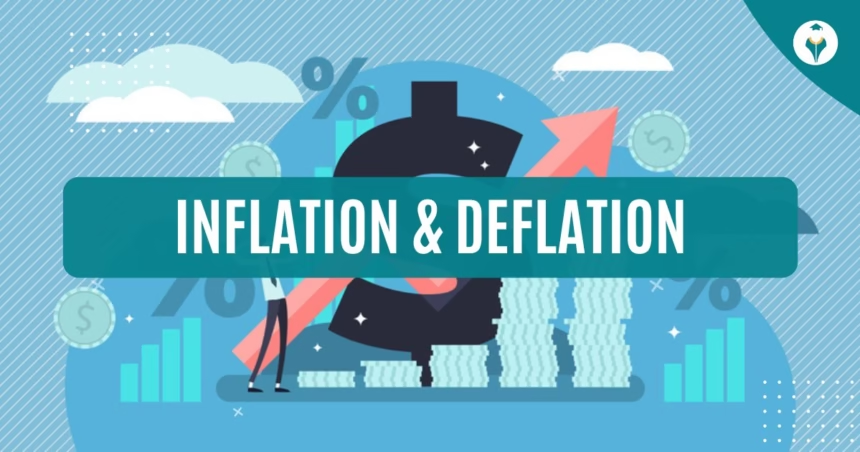Prices move like tides. Sometimes they wash higher, sometimes they pull back. When prices rise, it is called inflation. When prices fall, it is called deflation. Think grocery bills that creep up each month, rent that renews at a higher rate, or fuel that costs a few dollars more per fill. That is inflation. If the bill shrinks over time and stores start discounting across the board, that is deflation.
In 2025, inflation has cooled from the peaks of 2022, but it has not vanished. Prices are still rising in many places, just more slowly. Economists call that disinflation, which means the pace of price increases is easing.
This guide breaks down both forces in plain language. It compares everyday signs, explains what drives them, and lays out real risks for jobs, savings, and debt. It ends with a clear view of which threat is bigger now, and offers a simple playbook for households and small businesses.
Inflation Made Simple: What It Is, Why It Happens, and Who Feels It
Inflation is a broad rise in prices over time. The same dollar buys less next year than it does today. People notice it first in day-to-day spending, long before they see any chart or report.
Smaller packages, higher rent, pricier meals, and fees that creep up each renewal are common clues. Families feel it at the till and at the pump. Businesses see it in supplier quotes and wage pressures.
What Inflation Looks Like in Daily Life
- Grocery prices inch up, and packs get smaller for the same price.
- Housing costs rise, from rent renewals to mortgage payments after resets.
- Transit and gas cost more, especially during busy travel seasons.
- Services like haircuts, childcare, and takeout raise prices to cover higher wages and inputs.
- Subscription prices go up a few dollars per month, then again a few months later.
Over time, a dollar buys less. A common gauge called the CPI (Consumer Price Index) tracks how the average cost of a basket of goods and services changes over time.
Main Causes of Inflation: Demand, Costs, Money, and Expectations
- Demand-pull: Too many buyers chasing too few goods. For example, a travel boom meets limited hotel space, so room rates jump.
- Cost-push: Inputs like energy, shipping, or wages go up, so businesses raise prices to cover costs. For example, a spike in fuel lifts delivery costs and final prices.
- Money and credit: Easier borrowing and more money in circulation can boost spending, which pushes up prices. For example, low rates spur car purchases, and dealer prices climb.
- Expectations: If people expect prices to rise, workers ask for higher pa,y and firms lift prices in advance. This can keep inflation going even as supply improves.
Who Wins and Who Loses When Prices Rise
- Potential winners: Borrowers with fixed-rate loans may repay with “cheaper” future dollars. Owners of assets like homes and some stocks can see values hold or grow if wages and demand keep up.
- Potential losers: Savers in cash see buying power shrink. Workers on fixed incomes fall behind faster. Low and fixed-income households feel a bigger pinch because essentials eat more of the budget.
- Businesses: Some pass on costs if demand is strong. Others absorb costs or lose sales if customers trade down or delay purchases.
2025 Snapshot: Disinflation and Sticky Costs
By 2025, inflation will have eased from the 2022 spike. Prices in many countries are still rising year over year, but at a slower pace. That is disinflation. Some categories remain sticky. Housing and many services often adjust slowly and can stay high. Goods that saw big supply chain shocks in 2021 to 2023 cooled as shipping and inventories improved.
In some economies, deflationary patches can appear, especially where growth slows and energy prices fall. For example, Thailand’s Negative Inflation Challenges in 2025 show how weaker demand and cheaper inputs can push overall prices lower for a time.
Deflation Explained: Why Falling Prices Can Still Hurt
Deflation is a broad decline in prices over time. It sounds friendly at first. Cheaper goods, smaller bills. The risk shows up in behaviour. If people expect lower prices later, they may wait to buy. Stores sell less, revenues fall, and jobs can get cut. That feedback loop can be hard to stop once it starts.
What Deflation Is and How It Starts
Deflation means the average price level drops across many goods and services for a sustained period. It can start with weak demand, too much supply, or tight credit that makes borrowing and spending harder. One simple chain looks like this: people delay spending, stores cut prices to entice buyers, profits fall, and investment slows.
Why Deflation Can Lead to a Downward Spiral
When wages and prices drop, debts feel heavier because the amount owed does not shrink. Households cut spending to service loans. Businesses face falling revenues yet fixed debts, so they trim costs, often starting with hiring and hours. Rising job losses weigh on demand, pushing prices down further. Banks grow cautious, credit tightens, and investment falls. Once this cycle sets in, it can persist and feed on itself.
History Lessons: The 1930s and Japan’s Lost Decades
- The 1930s: The Great Depression delivered sharp price drops and deep unemployment. Spending and investment collapsed. Recovery required major policy shifts.
- Japan’s “lost decades”: Long stretches of low inflation or deflation, weak demand, and slow wage growth kept the economy subdued. Even as prices stabilized, momentum was hard to rebuild.
The takeaway is clear. Deflation is rare, but once entrenched, it is hard to escape.
Early Warning Signs to Watch
- Overall price indices have been falling for months, not just a few items on sale
- Shrinking wages or reduced hours across sectors
- Rising unemployment or underemployment
- Falling business investment and cancelled projects
- Tighter bank lending and tougher loan standards
- Rising defaults or bankruptcies
Short-term discounts or a drop in one category, like electronics, are not deflation on their own.
Inflation vs Deflation in 2025: Which Threatens the Economy More?
In 2025, inflation is the larger risk in most major economies. Price growth has cooled from 2022 peaks, but it remains above central bank targets in many places. Deflation is being monitored, especially where growth slows or credit tightens, but it is not the central case globally. The balance of risks still favours inflation as the bigger threat to household budgets, debt management, and stable growth.
Side-by-Side Risks: Stability, Debt, and Spending
- Inflation: Money loses buying power over time.
- Deflation: Money gains buying power, but spending can freeze.
- Inflation: Borrowers with fixed-rate debt may benefit.
- Deflation: Borrowers struggle as wages and prices fall.
- Inflation: Can mask weak productivity for a while.
- Deflation: Exposes weak demand and pushes layoffs.
- Inflation: Central banks can raise rates to cool demand.
- Deflation: Rates near zero leave fewer policy tools.
Central Bank Goals and Tools: Why 2 Percent Matters
Most central banks aim for about 2 percent inflation. That level supports steady wage growth, keeps debt service manageable, and avoids the traps of both high inflation and deflation. Their tools include policy interest rates, guidance on future moves, and balance sheet actions that affect credit conditions. From 2022 to 2024, many banks raised rates to slow inflation. In 2025, they are watching data closely to avoid tightening too far as inflation eases.
2025 Outlook: Inflation Still Tops the Risk List
Global inflation is lower than during the 2022 peak, yet remains elevated compared to pre-pandemic norms. Central banks still see the risk of inflation staying sticky, especially in services and housing. Deflation is less likely, but it could emerge in pockets if growth slows sharply and lending standards tighten. For now, the base case is moderating inflation, not a broad deflation cycle.
What This Means for Households and Small Businesses
- Watch essential costs: rent, food, transport, utilities, and childcare.
- Favour fixed rates when rate hikes seem likely or budgets are tight.
- Keep a cash buffer for surprise bills and income gaps.
- Avoid heavy variable-rate debt that can reset higher.
- Review subscriptions and services; trim low-value extras.
- For long-term goals, consider modest, diversified investing rather than timing markets.
For short-term reserves, some households look to quick-access options. See Liquid Funds as 2025 Emergency Savings Options for an overview of features and trade-offs.
Practical Playbook: Planning for Either Price Path
The smartest plan works in both inflation and deflation. The focus is on simple habits that improve stability regardless of where prices move next.
Budget Moves That Protect Essentials
- Map needs versus wants, then protect needs first.
- Lock in predictable costs where it is fair and clear, like fixed-rate utilities or annual payments that save over monthly fees.
- Set small, steady savings goals. Automate them if possible.
- Review the big bills twice a year, including insurance, phone, internet, and memberships.
Debt and Savings: Fixed vs Variable and Emergency Funds
Fixed-rate debt brings payment certainty. Variable-rate debt can cost less at first, but payments can rise when rates move up. In uncertain times, many households prefer stability, even if the initial rate is a bit higher. Aim for a basic emergency fund worth about three months of essential expenses if possible. Pay down high-interest debt first, since those rates can compound faster than most savings grow.
Investing Basics: Diversification and Time Horizon
A diversified mix helps spread risk across different assets. That spread can soften hits from both inflation and deflation shocks over time. The time horizon matters more than the latest headline. Long-term goals usually benefit from staying invested, rebalancing as needed, and keeping costs sensible. Product choice depends on personal needs, but the core idea is the same: mix, spread out, think long term.
Smart Shopping and Pay
- Use unit pricing to compare value across sizes and brands.
- Buy seasonally when produce and goods are cheaper.
- Track renewal dates for subscriptions and renegotiate or cancel.
- In inflationary periods, workers may seek cost-of-living raises. In softer markets, many prioritize job stability and skill growth.
- Small businesses can review vendor contracts, seek volume discounts, and adjust menus or bundles to maintain value without losing customers.
Conclusion
Inflation remains the larger risk in 2025, even as it has cooled from the 2022 highs. Deflation is less likely now, but it is serious if it appears and can be hard to reverse. The next steps are simple. Follow price data and central bank updates, keep a clear plan for cash, debt, and essentials, and review that plan every quarter. A calm, consistent approach beats chasing every headline.














